INTRODUCTION
Various approaches of brachial plexus block have been used for upper limb surgeries but supraclavicular brachial plexus block is mainly used for any surgery in the upper extremity that does not involve the shoulder because it is a safe technique with rapid onset and reliable anesthesia.1
Various local anesthetics have been used to provide brachial plexus block. Ropivacaine, a long-acting amide local anaesthetic related structurally to bupivacaine, has been used for supraclavicular block in upper limb surgery. It provides pain relief with less motor blockade and is less cardiotoxic than bupivacaine, which makes it a more suitable agent for supraclavicular brachial plexus block.
A variety of adjuvant has been already studied for brachial plexus blockade. Dexmedetomidine, a highly selective α-2 agonist with a relatively high ratio of α-2:α-1 activity (1620:1 as compared to 220:1 for clonidine), possesses all these properties but lacks respiratory depression, making it a useful and safe adjunct in diverse clinical applications. Presynaptic alpha-2 adrenoceptors are present in sympathetic nerve endings and noradrenergic neurones in the central nervous system (CNS) where dexmedetomidine binds and inhibits the release of noradrenaline. Dexmedetomidine has been already used for intravenous regional anesthesia.2 Dexmedetomidine has shown greater affinity as an α-2 adrenoreceptor agonist than clonidine. The effect of dexmedetomidine when added to lidocaine for intravenous regional anaesthesia, demonstrated that addition of 1 mcg/kg dexmedetomidine to lidocaine improves quality of anaesthesia and intraoperative as well post-operative analgesia without causing side effects.3
Dexmedetomidine has not been associated with respiratory depression, despite frequently profound levels of sedation. It decreases sympathetic tone, with attenuation of neuroendocrine and haemodynamic responses to anaesthesia and surgery, reduces anaesthetic requirement, causes sedation and analgesia. Because of arousable sedation, lack of respiratory depression and analgesia sparing effect, dexmedetomidine might prove useful in post-operative period for patient undergoing surgical procedures that are associated with significant pain.
The purpose of this study is to compare the hemodynamic, sedative, and analgesic effects of ropivacaine alone versus ropivacaine given along with dexmedetomidine.
The present study was carried out on patients undergoing elective upper limb surgery during the period from May, 2013 to May, 2014 for period of 12 months.
The study was carried out to compare haemodynamic, sedative, sensory and motor effects of ropivacaine alone and ropivacaine along with dexmedetomidine in supraclavicular brachial block in upper limb surgery. Institutional Ethics Committee (IEC) approval was obtained. It was prospective, randomized and double-blinded study. The study included total 60 patients belonging to ASA grade I and II of either sex with age between 18-60 years posted for various elective upper limb surgery. Sample size was decided in consultation with a statistician. Most of the past studies on brachial plexus block were done with the sample size of total 60 patients. After observing results of various similar studies, it was considered that a clinically significant benefit of using dexmedetomidine would be a prolongation in sensory block duration of 15% (minimum) compared with the control group. Based on these estimates, we calculated a sample size that would permit a type I error of α=0.005 and power of 80%. Enrolments of 25 patients in each group was required. Considering the dropouts, 30 patients were selected in each of the group.
MATERIALS AND METHODS
Informed consent was taken from each patient who meets the following inclusion and exclusion criteria’s. Inclusion criteria’s were ASA I-II adult subjects, age between 18-60 years, of either sex, elective upper limb surgery, willingness to be contacted post-operatively. Exclusion criteria were age<18 or >60, body mass index (BMI)>35, ASA grade>II, any upper limb surgery involving shoulder, inability to understand protocol due to language barrier, hypersensitivity to amide local anesthetics or dexmedetomidine, uncontrolled anxiety, schizophrenia or bipolar disorder, pre-existing nerve damage in the extremity to be blocked, significant cardiovascular disease, renal impairment (creatinine>2.0 mg/dL), pregnancy.
Patients meeting the inclusion criteria during the pre-anaesthetic evaluation were randomly assigned into 2 groups of 30 each with the help of a computer-generated table of random numbers by simple randomization method. Total 31 ml of solution for supraclavicular brachial plexus blockade was administered as follows: patients of Group-R received injection ropivacaine (0.75%) 30 ml and 1 ml normal saline. Patients of Group-RD received injection ropivacaine (0.75%) 30 ml and dexmedetomidine 25 µg diluted in 1 ml normal saline.
Pre-anaesthetic evaluation was done on the evening before surgery. All patients included in the study were premedicated with tablet alprazolam 0.5 mg and ranitidine 150 mg orally at night before surgery.
On arrival of patients in the operating room, a 20 gauge intravenous cannula was inserted on the non-operating hand and infusion of normal saline was started. The patients were connected with monitor to record heart rate (HR), non-invasive measurement of systolic blood pressure (SBP), diastolic blood pressure (DBP), continuous electrocardiogram (ECG) monitoring and haemoglobin oxygen saturation (SpO2). The baseline systolic BP, diastolic BP and HR were recorded.
One of the anaesthesiologists not involved in the care or monitoring of the patient, prepared the local anaesthetic study solutions. The patients and the observing anaesthesiologist as well as the physicians and nurses of the acute pain service were blinded to the study drug used.
The patients were placed in dorsal recumbent position with the head turned away from the site of injection. The injection site was infiltrated with 1 ml of lidocaine 2% subcutaneously. A nerve stimulator was used to locate the brachial plexus. Nerve stimulator “B Braun Stimuplex Dig RC” with needle length of 5 cm was used for the study. The location end point was a distal motor response with an output lower than 0.6 mA. During injection, negative aspiration was performed after every 6.5-7.0 ml to avoid intravascular injection.
Sensory and motor block along with monitoring of vitals was determined every 5 mins in first 30 mins and then every 15 mins during 1st hr followed by every 2nd hourly during 24 hrs. Any hypersensitivity reaction for the drugs, evidence of pneumothorax, and other adverse events were also monitored. To evaluate duration sensory block and motor block, patients were asked to inform the time when incisional discomfort as a sensation of pain began and also the time when full power returned to the shoulder. In the post-operative period, when the patient complained of pain at the operative site, injection Diclofenac 75 mg I/M was given. Patients were followed-up for 24 hrs for any side effects.
Sensory block was determined by the response to pin prick method using a visual analogue scale (VAS): [0-no pain, 2-mild pain, 5-moderate pain, 8-severe pain, 10-unbearable pain]. Assessment of motor blockade was done by bromage 3 point score. Assessment of sedation was done by Ramsay Sedation Scale.
Study parameters were defined as:
Onset of Sensory Blockade
Sensory block was assessed as loss of pinprick sensation using the blunt needle. Dermatomes C5 to T1 were assessed. Onset time is the time from the completion of injection of study drug till the loss of pinprick sensation completely.
Onset of Motor Blockade
Onset time of motor blockade is defined as the time from the completion of injection of study drug to paralysis of the upper limb.
Duration of Sensory Blockade
Duration of sensory blockade is the time from the onset of sensory blockade to till the patient’s complaints of pain at the site of surgery. Rescue analgesia was given after that only.
Duration of Motor Blockade
Duration of motor blockade is the time from the onset of motor blockade to complete recovery of motor power.
Haemodynamic parameters were recorded at 0, 5, 10, 15, 20, 25, 30, 45 mins, 1st hr, 2nd hr and thereafter every second hourly till 24 hrs.
Post-operatively, all patients received routine analgesic intramuscular injection Diclofenac 75 mg when they started feeling pain (VAS>3). Time for first dose of rescue analgesic in post-operative period and total rescue analgesic requirement in 24 hrs were recorded. The maximum pain scores and Ramsay sedation score at different time intervals (at 0, 5, 10, 15, 20, 25, 30, 45 mins, 1st hr, 2nd hr and thereafter every second hourly till 24 hrs in post-operative period) for each patient were recorded.
Incidences of nausea and vomiting, respiratory depression and sedation were noted. All the parameters were recorded as per the proforma and subjected to statistical analysis.
Statistical Analysis
Data were expressed as mean values±standard deviation/standard error, percentages (%), and numbers (n). The statistical analysis was performed by a statistician using Windostat Version 9.2. Two statistical tests were primarily used to analyze the data and p value<0.05 was considered as statistically significant.
1) t-tests were used to analyze differences between 2 groups.
2) Analysis of variance (ANOVA) to analyze differences in parameters such HR, SBP, DBP, VAS score and Ramsay sedation scores over a period of time.
RESULTS
There was no significant difference in the study groups with regards to demographic profile and duration of surgery (Table 1). The onset of sensory and motor blockade was faster in Group-RD than Group-R. Onset of sensory block was (Group-R=14.133±1.676 min and Group-RD=12.667±1.213 min) (p=0.000), Onset of motor block was (Group-R=25.967±2.748 min and Group-RD=23.333±3.467 min) (p=0.002)} (Table 2). Total duration of sensory blockade and motor block was longer in Group-RD. Total duration of sensory blockade was Group-R=547.833± 26.152 mins, Group-RD=811.667±25.405 mins (p value=0.000)}, and motor blockade was Group-R=509.667±24.703 mins, Group-RD=760.667±28.062 mins (p value=0.000)} (Table 2) (Figure 1). The total number of rescue injections in 24 hrs was less in the study group, Group-R=2.733±0.450, Group-RD=1.400±0.498 (p value=0.000) which was significantly different in 2 groups.
| Table 1: Demographic profile of patients. |
|
Demographic profile
|
Group-R(n=30) |
Group-RD(n=30) |
p value |
| Mean±SD |
Mean± SD |
| Age (years) |
38.233±11.723 |
35.633±9.661 |
0.352
|
|
Weight (kgs)
|
58.1±6.472 |
58.4±5.763 |
0.850 |
| Height (cms) |
159.5±4.632 |
159.8±3.881 |
0.787
|
|
Gender ratio(M:F)
|
17:13 |
14:16 |
0.446 |
| Table 2: Onset time and duration of motor and sensory block and duration of surgery. |
|
Variables
|
Group R (n=30)Mean±SD |
Group RD (n=30)
Mean±SD |
p value |
| Onset of sensory block (in min) |
14.133±1.676 |
12.667±1.213 |
0.000
|
|
Onset of motor block (in min)
|
25.967±2.784 |
23.333±3.467 |
0.002 |
| Duration of sensory block (in min) |
547.833±26.152 |
811.667±25.405 |
0.000
|
|
Duration of motor block (in min)
|
509.667±24.703 |
760.667±28.062 |
0.000 |
| Duration of surgery (in min) |
101.633±31.012 |
103.500±33.040 |
0.822 |
Figure 1: Bar graph showing comparision between duration of sensory and motor blockade.
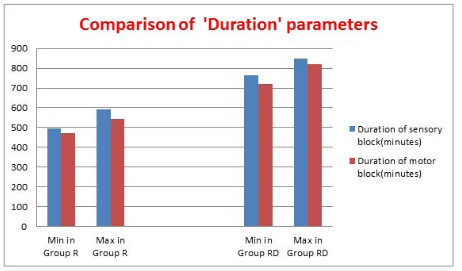
(Table 3). There was good haemodynamic stability in both groups. Heart rate in Group-R and Group-RD were comparable. The difference was statistically not significant (p=0.476). There was no fall or rise in heart rate more than 15 beats in both groups (Figure 3). SBP and DBP in Group-R and Group-RD with p values 0.416 and 0.784 were comparable between the groups. The difference was statistically not significant (Figures 4 and 5). We found that there was no significant difference among the 2 groups in total 24 hrs of duration with respect to parameters like HR, SBP, and DBP. There was no incidence of any side effects in both groups. There was no incidence of hypotension and bradycardia in any of the 60 patients. The mean Ramsay sedation scores (RSS) of Group-R was almost equal to Group-RD. The difference was not significant (p=0.169) (Figure 2). Patients in Group-RD had zero VAS score for a longer duration than those in Group-R. Differences in VAS scores of the 2 groups was statistically significant (p=0.000) (Figure 6).
Figure 3: Heart rate at different time intervals in both groups.
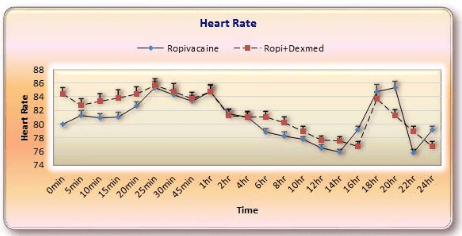
Figure 4: Systolic blood pressure (mmHg) at different intervals in both the groups.
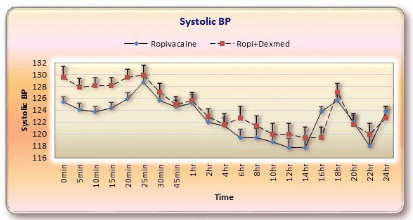
Figure 5: Diastolic blood pressure (mmHg) at different time intervals in both the groups.
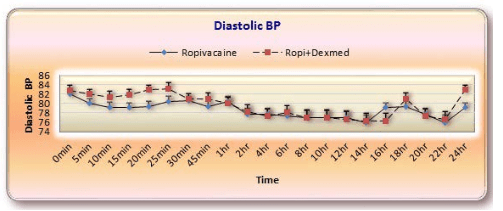
Figure 6: VAS scores at different time intervals.
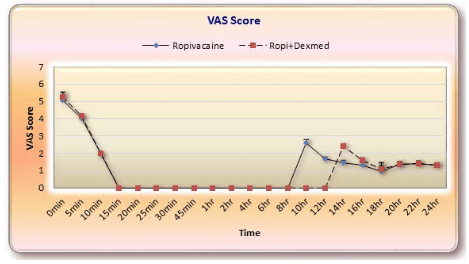
| Table 3: Comparison of number of rescue injections in 24 hours. |
|
Total number of rescue injection in 24 hours
|
Group-R Group RD
(n=30) (n=30) |
p value
|
|
Mean±SD Mean±SD
|
|
2.733±0.450 1.400±0.498
|
0.000
|
Figure 2: Comparision between sedation scores both the groups.
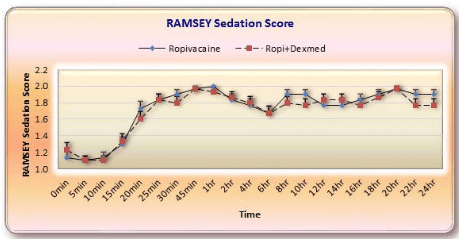
DISCUSSION
Dexmedetomidine is being used for intravenous regional anesthesia (Bier’s block), intravenous sedation and analgesia for intubated and mechanically ventilated patients in intensive care units and non-intubated patients for surgical and other procedures. It has been reported to improve the quality of intrathecal and epidural anaesthesia. Its use in peripheral nerve blocks has been described. However, the reports of its use in supraclavicular brachial plexus block are limited. In this study, we investigated whether adding dexmedetomidine to ropivacaine for supraclavicular brachial plexus block would affect the sensory and motor blocks and duration of analgesia. Results in a study done with end stage renal disease showed that the motor and sensory block was longer in the dexmedetomidine group.4 In a prospective double-blinded study on 70 patients, it was found that dexmedetomidine gives better haemodynamic stability and greater post-operative analgesia.5 The effect of dexmedetomidine on brachial plexus block with ropivacaine and upper extremity ischemia-reperfusion injury in patients undergoing upper extremity surgery showed that dexmedetomidine can not only enhance the efficacy of brachial plexus block with ropivacaine, but also reduce the upper extremity ischemia reperfusion injury caused by tourniquet in patients undergoing upper extremity surgery.6 A prospective, randomized, double-blinded, placebo-controlled trial on 50 patients, undergoing upper limb surgery under supraclavicular brachial plexus block to compare the effects of adding dexmedetomidine to a 30 ml solution of 0.325% bupivacaine in supraclavicular brachial plexus block showed that dexmedetomidine when added as an adjuvant to bupivacaine for supraclavicular brachial plexus block significantly shortens the onset time and prolongs the duration of sensory and motor blocks and duration of analgesia.7
The duration of analgesia, when only local anaesthetic is used is very short and does not extend into post-operative period for more than 3-4 hrs. Various drugs have been tried as adjuvant to local anaesthetics for prolonging the analgesia and improving the quality of block. Dexmedetomidine has been introduced in India in parenteral form and the effectiveness of the same for supraclavicular brachial plexus block has not been investigated in India, as very few studies have been done regarding the same. Hence, we selected dexmedetomidine as an adjuvant to ropivacaine in our study.
Ropivacaine has been found to be equally effective as bupivacaine for brachial plexus block by various authors.8,9 Hence, ropivacaine was selected as local anaesthetic for our study.
In our study we used only 25 µg dexmedetomidine as adjunct to ropivacaine, because there are more chances to have bradycardia and hypotension with higher doses of dexmedetomidine.10
Various authors have used different volumes of ropivacaine for brachial plexus block. We used 30 ml of local anesthetic solution for brachial plexus block basing on few papers selected for our study.11,12,13
In a randomized double-blinded study of effects of dexmedetomidine added to caudal ropivacaine in paediatric lower abdominal surgeries found that caudal dexmedetomidine with 0.25% ropivacaine for paediatric lower abdominal surgeries achieved significant post-operative pain relief that resulted in better quality of sleep and prolonged duration of arousable sedation and produced less incidence of emergence agitation following sevoflurane anaesthesia.14
In our study haemodynamic parameters (HR, SBP, and DBP) were recorded at 0, 5, 10, 15, 20, 25, 30, 45 mins, 1st hr, 2nd hr and thereafter every second hourly till 24 hrs. There wasn’t any incidence of fall in blood pressure more than 20 mmHg compare to baseline reading. No patient had respiratory depression, bradycardia or tachycardia. This shows that dexmedetomidine is not producing side effects like bradycardia and hypotension if it is used in small doses (less than 30 mg) as an adjuvant with local anesthetics in supraclavicular brachial plexus block.
CONCLUSION
Dexmedetomidine in a dose of 25 µg added to ropivacaine in supraclavicular brachial block for upper limb surgery significantly shortens the onset time and prolongs the duration of sensory and motor blocks without producing sedation in patients. Total number of rescue analgesics required in post-operative period is also less with use of dexmedetomidine as an adjuvant to ropivacaine.
ACKNOWLEDGEMENTS
The authors are very thankful to Dr. Rajeshwar Rao, Consultant Anaesthesiologist at Department of Anaesthesia in Yashoda Hospital for his suggestion and guidance. The authors are also thankful to Mr. Murli Mohan Khetan for his help in statistical analysis. They gratefully acknowledge management of the hospital for their valuable support.
CONFLICTS OF INTEREST
The authors declare that they have no conflicts of interest.











